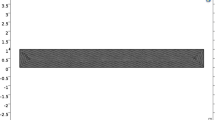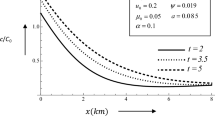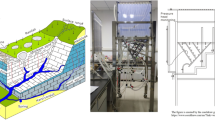Abstract
River–groundwater interactions, accompanied by solute transport, are one of the most important contemporary challenges. Non-Fickian diffusion behavior has been extensively documented for solute transport in groundwater or river, but less in river–groundwater system. This paper confirms the existence of anomalous diffusion in the river–groundwater system by experiments and then accurately describes the solute transport process by fractional derivative model, especially for the long-time power law tailing characteristic. Laboratory experiment in inter-river land sample shows that the time fractional advection–dispersion equation, which has a parameter (time index \(\alpha\)) defining memory function and other basic transport parameters (velocity v and dispersion coefficient D) with the different hydrogeologic significances, provides a prominent improvement in simulating non-Fickian diffusion behavior compared with the classical advection–dispersion equation. Analysis results indicate that low flow rates reduce mass exchange between the mobile and immobile domains, resulting in late-time heavy tailing phenomenon. In a word, this study provides a new approach to improve our understanding on solute transport in the interfluve with river–groundwater interactions.








Similar content being viewed by others
Data Availability Statement
This manuscript has associated data in a data repository. [Authors’ comment: All experimental data were conducted in Hefei University of Technology (China). Some or all data, models, or code that support the findings of this study are available from the corresponding author upon reasonable request.]
References
N. Su, P.N. Nelson, S. Connor, The distributed-order fractional diffusion-wave equation of groundwater flow: theory and application to pumping and slug tests. J. Hydrol. 529(10), 1262–1273 (2015). https://doi.org/10.1016/j.jhydrol.2015.09.033
P. Brunner, R. Therrien, P. Renard, C.T. Simmons, H.H. Franssen, Advances in understanding river-groundwater interactions: river-groundwater interactions. Rev. Geophys. 55(3), 818–854 (2017). https://doi.org/10.1002/2017RG000556
D. Lapworth, N. Baran, M. Stuart, R. Ward, Emerging organic contaminants in groundwater: a review of sources, fate and occurrence. Environ. Pollut. 163, 287–303 (2012). https://doi.org/10.1016/j.envpol.2011.12.034
D.W. Meals, S.A. Dressing, T.E. Davenport, Lag time in water quality response to best management practices: a review. J. Environ. Qual. 39(1), 85–96 (2010). https://doi.org/10.2134/jeq2009.0108
W.W. Woessner, Stream and fluvial plain ground water interactions: rescaling hydrogeologic thought. Groundwater 38(3), 423–429 (2000). https://doi.org/10.1111/j.1745-6584.2000.tb00228.x
L. Lambs, Interactions between groundwater and surface water at river banks and the confluence of rivers. J. Hydrol. 288(3), 312–326 (2004). https://doi.org/10.1016/j.jhydrol.2003.10.013
B. Bijeljic, A. Raeini, P. Mostaghimi, M.J. Blunt, Predictions of non-fickian solute transport in different classes of porous media using direct simulation on pore-scale images. Phys. Rev. E 87(1), 013011 (2013). https://doi.org/10.1103/PhysRevE.87.013011
B. Berkowitz, G. Kosakowski, G. Margolin, H. Scher, Application of continuous time random walk theory to tracer test measurements in fractured and heterogeneous porous media. Groundwater 39(4), 593–604 (2001). https://doi.org/10.1111/j.1745-6584.2001.tb02347.x
R. Haggerty, S.M. Gorelick, Multiple-rate mass transfer for modeling diffusion and surface reactions in media with pore-scale heterogeneity. Water Resour. Res. 31(10), 2383–2400 (1995). https://doi.org/10.1029/95WR10583
R. Schumer, D.A. Benson, M.M. Meerschaert, B. Baeumer, Fractal mobile/immobile solute transport. Water Resour. Res. 39(10), 1296–1307 (2003). https://doi.org/10.1029/2003WR002141
A.J. Valocchi, Validity of the local equilibrium assumption for modeling sorbing solute transport through homogeneous soils. Water Resour. Res. 21(6), 808–820 (1985). https://doi.org/10.1029/WR021i006p00808
R. Therrien, E. Sudicky, Three-dimensional analysis of variably-saturated flow and solute transport in discretely-fractured porous media. J. Contam. Hydrol. 23(1–2), 1–44 (1996). https://doi.org/10.1016/0169-7722(95)00088-7
B. Lu, Y. Zhang, C. Zheng, C.T. Green, C. O’Neill, H.G. Sun, J. Qian, Comparison of time nonlocal transport models for characterizing non-fickian transport: from mathematical interpretation to laboratory application. Water 10(6), 778 (2018). https://doi.org/10.3390/w10060778
B. Berkowitz, A. Cortis, M. Dentz, H. Scher, Modeling non-fickian transport in geological formations as a continuous time random walk. Rev. Geophys. 44(2), RG2003 (2006). https://doi.org/10.1029/2005RG000178
B. Lu, X. Liu, P. Dong, G.R. Tick, C. Zheng, Y. Zhang, M. Mahmood-UI-Hassan, H. Bai, E. Lamy, Quantifying fate and transport of nitrate in saturated soil systems using fractional derivative model. Appl. Math. Model. 81, 279–295 (2020). https://doi.org/10.1016/j.apm.2019.12.005
M.H. Puckett, Y. Zhang, B. Lu, Y. Lu, H.G. Sun, C. Zheng, W. Wei, Application of fractional differential equation to interpret the dynamics of dissolved heavy-metal uptake in streams at a wide range of scales. Eur. Phys. J. Plus 134(8), 377 (2019). https://doi.org/10.1140/epjp/i2019-12897-1
Y. Zhang, R.L. Martin, D. Chen, B. Baeumer, H.G. Sun, L. Chen, A subordinated advection model for uniform bed load transport from local to regional scales. J. Geophys. Res. Earth Surf. 119(12), 2711–2729 (2014). https://doi.org/10.1002/2014JF003145
Y. Zhang, L. Chen, D.M. Reeves, H.G. Sun, A fractional-order tempered-stable continuity model to capture surface water runoff. J. Vib. Control 22(8), 1993–2003 (2016). https://doi.org/10.1177/1077546314557554
N. Su, P.N. Nelson, S. Connor, The distributed-order fractional diffusion-wave equation of groundwater flow: theory and application to pumping and slug tests. J. Hydrol. 529, 1262–1273 (2015). https://doi.org/10.1016/j.jhydrol.2015.09.033
J. Qian, H. Zhan, W. Zhao, F. Sun, Experimental study of turbulent unconfined groundwater flow in a single fracture. J. Hydrol. 311(1–4), 134–142 (2005). https://doi.org/10.1016/j.jhydrol.2005.01.013
D. Nielsen, J. Biggar, Miscible displacement: Iii. theoretical considerations. Soil Sci. Soc. Am. J. 26(3), 216–221 (1962). https://doi.org/10.2136/sssaj1962.03615995002600030010x
M. Caputo, Linear models of dissipation whose q is almost frequency independent-ii. Geophys. J. Int. 13(5), 529–539 (1967). https://doi.org/10.1111/j.1365-246X.1967.tb02303.x
Y. Zhang, M.M. Meerschaert, B. Baeumer, Particle tracking for time-fractional diffusion. Phys. Rev. E 78(3), 036705 (2008). https://doi.org/10.1103/PhysRevE.78.036705
D.A. Murio, Implicit finite difference approximation for time fractional diffusion equations. Comput. Math. Appl. 56(4), 1138–1145 (2008). https://doi.org/10.1016/j.camwa.2008.02.015
W. Deng, Finite element method for the space and time fractional fokker-planck equation. SIAM J. Numer. Anal. 47(1), 204–226 (2009). https://doi.org/10.1137/080714130
F. Liu, P. Zhuang, I. Turner, K. Burrage, V. Anh, A new fractional finite volume method for solving the fractional diffusion equation. Appl. Math. Model. 38(15–16), 3871–3878 (2014). https://doi.org/10.1016/j.apm.2013.10.007
K. Diethelm, N.J. Ford, A.D. Freed, A predictor-corrector approach for the numerical solution of fractional differential equations. Nonlinear Dyn. 29(1), 3–22 (2002). https://doi.org/10.1023/A:1016592219341
I. Ahmad, H. Ahmad, P. Thounthong, Y.M. Chu, C. Cesarano, Solution of multi-term time-fractional pde models arising in mathematical biology and physics by local meshless method. Symmetry 12(7), 1195 (2020). https://doi.org/10.3390/sym12071195
H. Sheng, Y. Li, Y. Chen, Application of numerical inverse laplace transform algorithms in fractional calculus. J. Franklin Inst. 348(2), 315–330 (2011). https://doi.org/10.1016/j.jfranklin.2010.11.009
J. Valsa, L. Brančik, Approximate formulae for numerical inversion of laplace transforms. Int. J. Numer. Model. Electron. Netw. Devices Fields 11(3), 153–166 (1998). https://doi.org/10.1002/(SICI)1099-1204(199805/06)11:33.0.CO;2-C
C.J. Willmott, K. Matsuura, Advantages of the mean absolute error (mae) over the root mean square error (rmse) in assessing average model performance. Climate Res. 30(1), 79–82 (2005). https://doi.org/10.3354/cr030079
D.R. Legates, G.J. McCabe Jr., Evaluating the use of “goodness-of-fit’’ measures in hydrologic and hydroclimatic model validation. Water Resour. Res. 35(1), 233–241 (1999). https://doi.org/10.1029/1998WR900018
Y. Zhang, H.G. Sun, C. Zheng, Lagrangian solver for vector fractional diffusion in bounded anisotropic aquifers: development and application. Fract. Calculus Appl. Anal. 22(6), 1607–1640 (2019). https://doi.org/10.1515/fca-2019-0083
J.F. Pickens, G.E. Grisak, Scale-dependent dispersion in a stratified granular aquifer. Water Resour. Res. 17(4), 1191–1211 (1981). https://doi.org/10.1029/WR017i004p01191
Acknowledgements
This research was funded by the National Natural Science Foundation of China, grant numbers U2267218, 11972148 and 41831289, the Natural Science Foundation of Jiangsu Province, Grant Number BK20190024, Key R &D Program of Anhui Province, Grant Number 201904a07020071.
Author information
Authors and Affiliations
Corresponding author
Rights and permissions
Springer Nature or its licensor (e.g. a society or other partner) holds exclusive rights to this article under a publishing agreement with the author(s) or other rightsholder(s); author self-archiving of the accepted manuscript version of this article is solely governed by the terms of such publishing agreement and applicable law.
About this article
Cite this article
Xu, Y., Sun, H., Qiao, C. et al. Non-Fickian transport of sodium chloride in inter-river land: experiment validation and fractional derivative modeling. Eur. Phys. J. Plus 137, 1275 (2022). https://doi.org/10.1140/epjp/s13360-022-03498-6
Received:
Accepted:
Published:
DOI: https://doi.org/10.1140/epjp/s13360-022-03498-6




